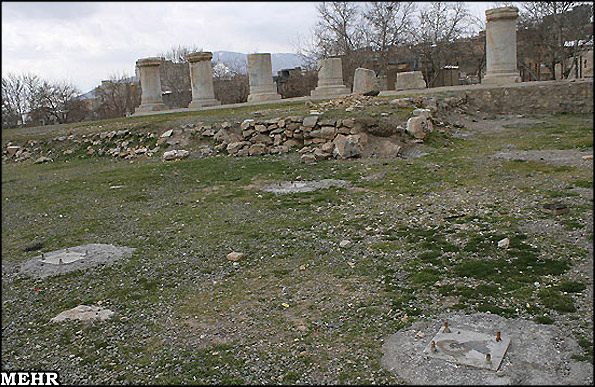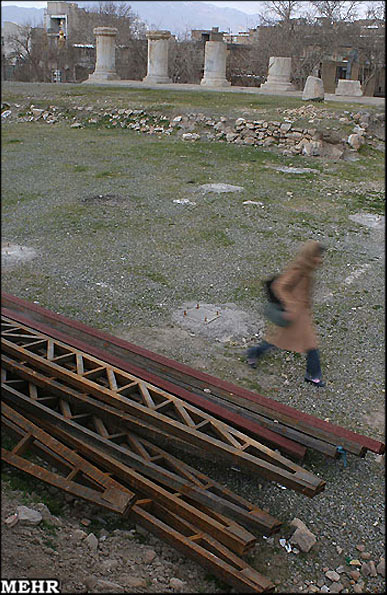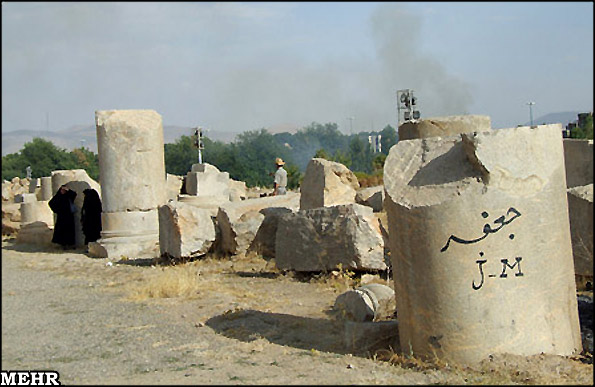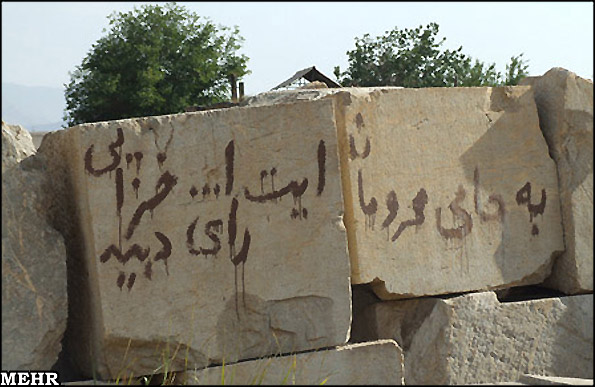See also original report by: The Circle of Ancient Iranian Studies
A massive “construction” project at the Anahita Temple in Kangavar in Kermanshah Province in western Iran was finally halted in the last week of January. The damage however has been done.
Thanks to Mehr News Agency of Iran who raised the alarm about the destruction being wrought against the site, the “construction” crews have been forced to stop; hopefully, to never return.
Who has been responsible for this latest assault on the pre-Islamic sites of ancient Iran? Before exploring this, it is necessary to briefly outline the backgound of the ancient Anahita Temple.
The Ancient Temple of Anahita
The general consensus is that the Anahita Temple was built during the early Parthian era around 200 BC, just over a century after the fall of the Achaemenid Empire. The site has seen continuous rebuiklding over the centuries, but it is generally believed that the Temple of Anahita was built during the Parthian era (248 BC – 224 AD). Nevertheless, definative judgements on the site await more excavations and studies.
The platform covers 4,600 square meters built over a mound 32 meters in height. It is generally believed that this ancient temple was established for the Zoroastrian-Iranic goddess ‘Aredvi Sura Anahita’ (Arədvī Sūrā Anāhitā). Anahita is the Iranic goddess of wisdom, purity, fertility, healing and Aban (the waters).
Given its construction in the early Parthian era, Kangavar also shows some Hellenistic characteristics, notably the edifice. The remaining architectural traits, however, can be traced to a the rise of a unique architectural tradition that was underway during this time in ancient Iran.
The Iranian propensity for size and grandeur is seen in the very large dimensions of consturction seen in the foundations at the Anahita Temple. What is especially Achaemenid in chatacter are two lateral stairways ascending the platform- this echoes what is seen in the Apadana Palace of ancient Persepolis of the Achaemenid kings.
“Construction” or Damage?
The Kangavar site was seriously damaged during an earthquake in 1957. Afterwards, some locals invaded the perimeter of the site, using stones from the temple to rebuild their homes at that location. In early 2010, however, serious damage was inflicted on the site as a result of “construction” activity.
From what is know through Mehr News in Iran, the responsible parties are the provincial department of the Islamic Republic Endowments and Charity Affairs based in Kangavar. These began to build concrete foundations in December 2009. The objective is to lay the basis for Imamzadeh Ebrahim located on the environs of the Anahita Temple.
Incredibly, the building of a hotel at the Anahita location is another part of the “construction”. This is in fact what happended at the ancient thousands-year old site of Susa in August 2008.
Asadollah Beiranvand, of the Kermanshah Cultural Heritage and Director of the Tourism and Handicrafts Department (KCHTHD) told the Mehr News Agency of Iran that:
“The construction project near the Anahita Temple was illegal so it was barred by a court order…the office had begun the project without receiving approval from the KCHTHD.”
In a repeat of the scenario of the disastrous “repairs” that were made on the Tomb of Cyrus at Pasargardae, Mehr News was again challenged, this time by Mohammad Qorbani (Director of KECAO).
Qorbani has categorically rejected Beiranvand’s warnings. He also claimed that the construction project had been approved, based on an agreement that took place between the KCHTHD and KECAO. Specifically, avers Qorbani, the development plan had actually been given the green light by the Cultural Heritage, Tourism and Handicrafts Organization as ealry as 1994. Qorbani then notes that for “unknown reasons” the plan had been delayed until ealry 2010.
According to the current version of events, the “construction” plan had been approved by the Governor General’s Office at Kermanshah in 2009. Qorbani then notes that the finalized version of that approval was signed during a meeting between KCHTHD KECAO and the Kermanshah governor general on December 19, 2009.
“Construction” or Damage? What do the Photos Say?
The foundations for the Imamzade near the Anahita Temple. It is mystery why the builders would come so close to this ancient site. This would be analogous to having modern construction crews build new buildings near ancient Stonehedge in England.
Woman passes by steel frames dumped at the ancient Temple of Anahita.
Graffiti? This action is analogous to vandalism – it is certain that nobody would dare do the same to the columns of the ancient Acropolis in Athens, Greece.
Graffiti once again seen sprayed (or written) on ancient blocks at the Anahita site. It is not clear if this action is an act of deliberate vandalism, or is simply a leisurely action by the “construction” crews.







